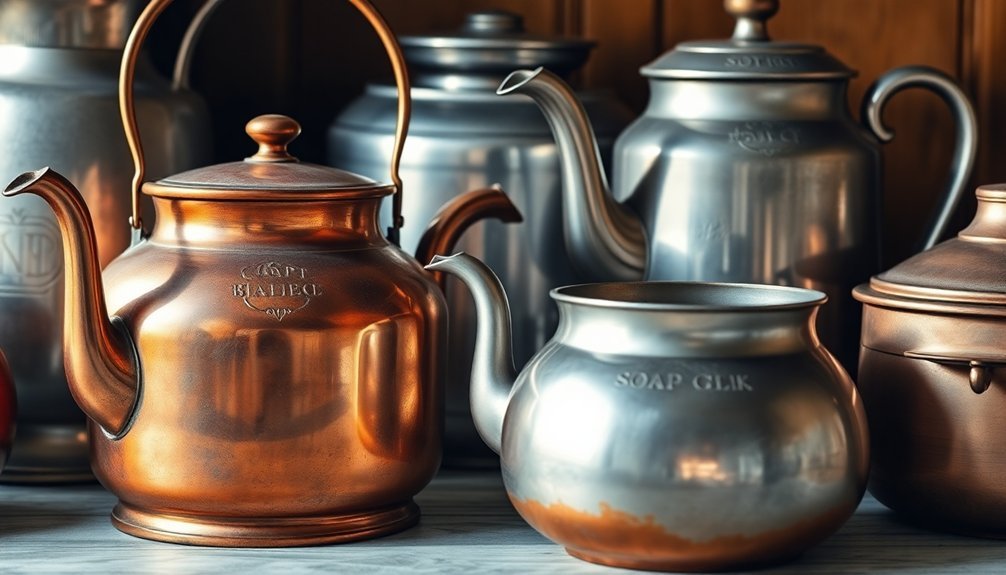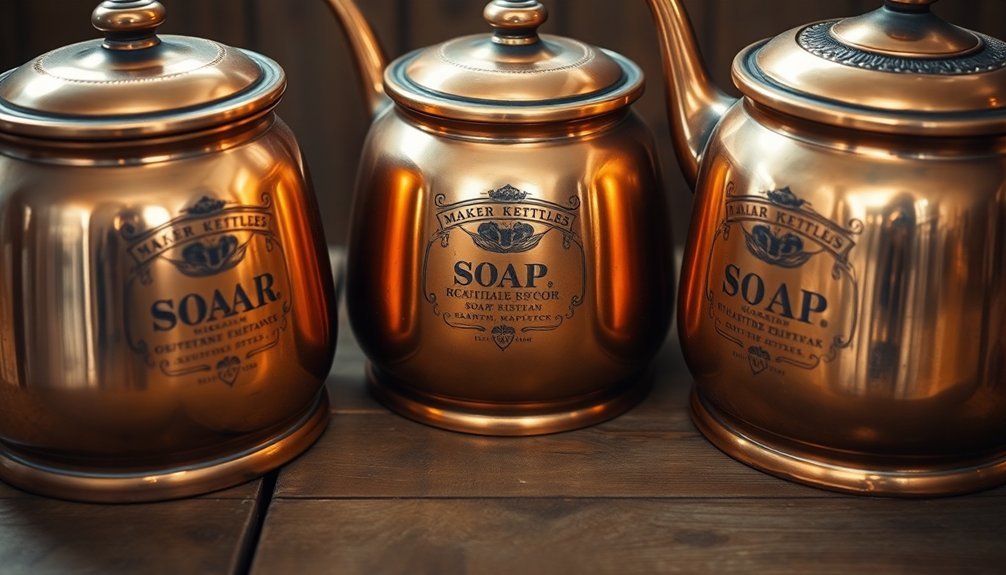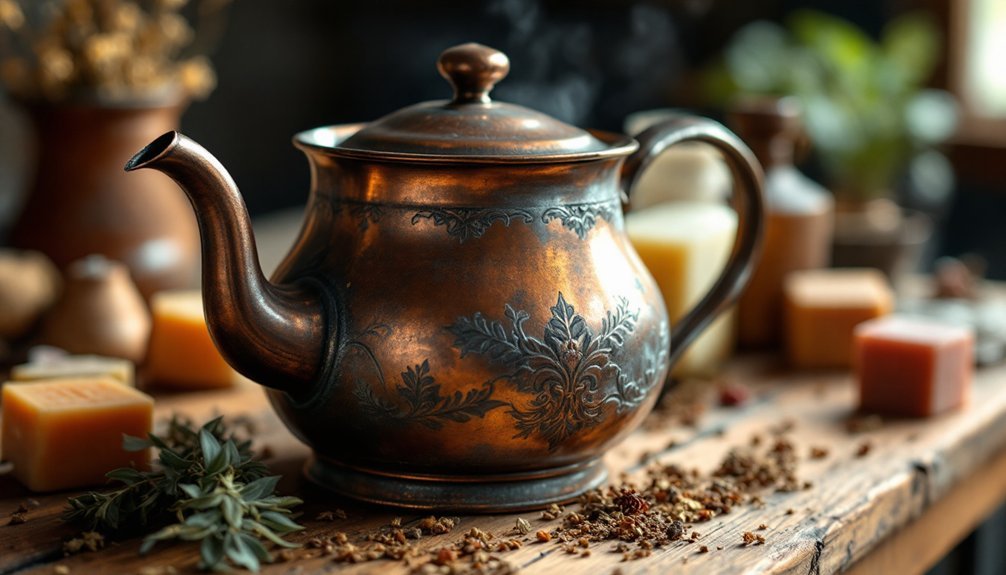Vintage soap kettles vary greatly in value today, ranging from $20 for basic aluminum models to over $1,000 for rare copper pieces. Your kettle's worth depends on age, condition, material, brand, and provenance. Copper commands premium prices due to superior heat conductivity, while original patina increases value by demonstrating authentic historical integrity. Consider seeking professional appraisal for the most accurate valuation, as subtle features often reveal a kettle's true market potential.
Determining the Market Value of Vintage Soap Kettles

While many collectors purchase vintage soap kettles for their aesthetic appeal, understanding their true market value requires examining several key factors.
Age and condition greatly impact pricing—older, well-preserved kettles typically command higher prices, especially those from recognized brands.
A pristine antique kettle from a notable manufacturer represents the pinnacle of soap-making collectibles.
Material quality and craftsmanship are essential considerations, with premium materials boosting value considerably. You'll find that kettles serving both functional and decorative purposes often fetch more than purely ornamental pieces. Vintage kettles that feature unique knobs like the sparrow design found on some decorative tea kettles can significantly increase collector interest and value.
For accurate valuation, consider professional appraisal services and research comparable sales on specialized platforms like Etsy or auction houses.
Regional demand varies greatly; a kettle might be worth more in areas with strong local interest in soap-making history.
Always verify authenticity through documentation and provenance to avoid overpaying for replicas or counterfeits.
Historical Factors Affecting Soap Kettle Prices
Historical context greatly shapes the market value of vintage soap kettles beyond their physical attributes. Economic conditions during a kettle's production era directly influenced material quality and craftsmanship—kettles made during resource-scarce periods often command higher prices due to their rarity.
Regional variations play an essential role too. You'll find soap kettles from areas with strong artisanal traditions, such as certain European communities, typically fetch premium prices compared to mass-produced alternatives. The emergence of copper and iron kettles represented a significant advancement in durability and heating efficiency over earlier materials.
The industrial revolution's impact can't be overlooked, as it marks the shift from handcrafted to machine-made vessels.
Cultural significance adds another layer of value. Kettles used in traditional soap-making practices or associated with specific communities often attract collectors willing to pay substantially more for their historical and cultural connections.
Material Considerations: Copper vs. Aluminum Values

When examining vintage soap kettles, material composition stands as the single most influential factor in determining market value. Copper kettles consistently command premium prices in the collectibles market, with antique pieces ranging from $140 to well over $1,000 depending on age, craftsmanship, and condition.
| Material | Value Range | Collector Appeal | Longevity |
|---|---|---|---|
| Copper | $140-$1,000+ | Extremely High | Exceptional |
| Aluminum | $20-$150 | Moderate | Good |
You'll find copper's superior heat conductivity, aesthetic appeal, and durability justify its higher price point. While aluminum kettles offer good heat conductivity and corrosion resistance, they lack the collectibility of their copper counterparts. When investing in vintage kettles, consider that proper maintenance considerably impacts value—polished copper pieces with intact linings will always fetch top dollar. Applying gentle copper cleaner according to product directions helps preserve both the appearance and value of antique copper kettles.
Condition Assessment: Original Patina vs. Restoration
When evaluating vintage soap kettles, you'll need to decide whether to preserve the original patina or pursue restoration, as this choice greatly impacts value.
You can identify professional restorations by examining uniformity in color, checking for modern materials, or finding inconsistencies in wear patterns. The presence of significant pitting after restoration may indicate previous severe rust damage that could affect the kettle's overall collectible value.
The most valuable kettles often maintain their historical integrity through original patina, which tells a story that restoration techniques simply can't replicate.
Patina's Historical Value
The rich patina found on vintage soap kettles serves as a tangible connection to history that many collectors prize above all other features.
When examining these artifacts, you're witnessing physical evidence of age and usage that validates authenticity and provenance.
A well-developed patina tells you stories about the kettle's journey through time. It reveals insights about craftsmanship techniques, materials used, and even environmental conditions the piece has endured.
You'll find that this natural aging process helps experts accurately date kettles and assess their historical significance. Similar to antique copper cookware, signs like green patches can indicate raw copper exposure, suggesting areas that may need professional attention.
While restoration might make a kettle more visually appealing to some, you should know that original patina typically commands higher prices at auction.
Collectors value these authentic marks of time because they're impossible to replicate – each patina is as unique as a fingerprint.
To Restore or Not?
Deciding whether to restore your vintage soap kettle presents one of the most challenging dilemmas for collectors and enthusiasts alike.
Before taking action, thoroughly assess your kettle's condition—check for rust, structural integrity, and historical consistency.
Original patina often increases value, especially for collectors who prize authenticity and historical character. Those small imperfections tell a story that restoration might erase forever.
However, professional restoration can revive functionality and visual appeal when damage is extensive.
Consider your intentions: Will you display or use the kettle? The market values both approaches differently.
If restoration seems necessary, hire professionals who understand period-appropriate techniques. Like Weber kettles, vintage soap kettles feature a durable enamel finish that can withstand careful restoration even after decades of neglect. Remember that aggressive cleaning with steel wool or harsh chemicals might permanently diminish your kettle's worth.
The best choice balances preservation of historical integrity with your personal goals.
Detecting Professional Restorations
Seasoned collectors develop a sharp eye for distinguishing between original patina and professional restorations, but you can learn these skills too. Look for evenly distributed patina that indicates natural aging rather than patchy areas suggesting selective restoration.
Authentic vintage kettles often display imperfect craftsmanship with visible hammer marks or uneven welds that aren't found in modern reproductions. Just as preservation experts assess historic buildings like the Red Dragon Reading Room for structural integrity, examining a soap kettle's construction reveals its authenticity.
- Trust your touch – Run your fingers across the surface to feel inconsistencies in texture that eyes might miss; original pieces have subtle variations that tell their unique story.
- Examine the hidden areas – Bottoms and interiors often retain original finishes as restorers focus on visible surfaces.
- Study the hardware – Original fixtures show matching wear patterns, while replacement parts appear conspicuously new.
Collector's Guide to Rare Soap Making Vessels
Since their inception, rare soap making vessels have captivated the attention of collectors worldwide, representing a fascinating intersection of historical utility and artistic craftsmanship.
When building your collection, focus on the five main types: copper kettles prized for conductivity, durable cast iron vessels, stylish brass alternatives, ornate wooden molds, and practical enamel-coated kettles.
You'll find that provenance greatly impacts value—vessels with documented history from notable households or manufacturers command premium prices.
Examine each piece carefully for signs of professional restoration, as original condition matters tremendously. Look for maker's marks, period-appropriate construction methods, and authentic patina.
If you're investing in these historical artifacts, consider storage conditions that prevent further degradation, particularly for copper and wooden pieces that require specialized care. Vintage kettles used in hot process soap making are especially valuable as they were designed to withstand the heating required for faster saponification.
Authenticating Antique Soap Kettles: Marks and Signatures

When you're examining a potential antique soap kettle, look for manufacturer's marks or signatures stamped into the metal as they'll help verify authenticity and origin.
The patina on brass or copper kettles reveals its age through consistent coloration patterns that can't easily be faked by modern reproductions.
You'll find genuine antiques often develop distinctive wear patterns where handles meet the kettle body, whereas artificially aged pieces show less realistic wear distribution.
Traditional soap kettles used for stirring with paddles were essential to prevent the mixture from boiling over during the long simmering process that lasted until late afternoon.
Maker's Marks Matter
The secret language of antique soap kettles lies hidden in their maker's marks and signatures, telling a story that collectors can't afford to ignore.
When examining a potential purchase, look carefully for initials, logos, or distinct symbols—often found on the base or handle—as these can authenticate your kettle's origin and greatly boost its value.
Some marks may be worn from decades of use, so examine with proper lighting or a magnifying glass. Similar to toxic bookcloth identification, wearing nitrile gloves when handling antique items can help protect you from potentially harmful residues.
- Excitement: Finding a rare maker's mark from a renowned craftsman can instantly transform your $50 flea market find into a $500+ treasure!
- Security: Verified marks protect you from reproductions and fakes flooding today's antique market.
- Heritage: Each authenticated mark connects you directly to the artisan's hands that crafted it generations ago.
Age-Revealing Patinas
Beyond maker's marks, a soap kettle's patina serves as its silent historian, revealing decades or even centuries of stories through its distinctive surface.
When examining vintage pieces, you'll notice each material develops its unique signature—copper acquires a greenish-blue hue, while brass darkens to deep green or brown tones.
Don't mistake patina for damage; it's a badge of authenticity that greatly enhances value.
Expert collectors can determine a kettle's age by evaluating the depth and uniformity of its surface transformation. Environmental factors like humidity, storage conditions, and handling all influence how these finishes develop over time. For valuable brass kettles, use mild soap and water to clean while preserving the historically significant patina.
When caring for your antique kettle, resist aggressive cleaning that might strip away this precious layer of history.
Gentle conservation preserves both the patina's beauty and your kettle's market value.
Displaying and Preserving Your Valuable Soap Making Artifacts
Properly displaying and preserving vintage soap kettles requires careful attention to both aesthetics and conservation techniques.
Mount your kettles on decorative stands or arrange them on shelves to highlight their unique shapes and historical significance. Always store them in cool, dry areas away from direct sunlight to prevent rust and deterioration. Consider creating a rhetorical star analysis to evaluate the historical context and cultural significance of each piece in your collection.
When handling your artifacts, use clean hands or gloves to avoid transferring oils that can damage surfaces. For iron or copper kettles, apply a thin protective layer of oil to prevent oxidation while maintaining their authentic appearance.
- Document each piece's history – connecting your collection to soap making traditions creates a meaningful legacy
- Create themed displays – arranging kettles alongside period-appropriate tools evokes a complete historical narrative
- Share their stories – teaching others about your artifacts' cultural significance preserves disappearing knowledge
Frequently Asked Questions
Can Vintage Soap Kettles Be Safely Used for Modern Soap Making?
While you can use vintage soap kettles for modern soap making, they're not ideal due to potential reactivity with lye. You'll need to guarantee they're thoroughly cleaned, not made of aluminum, and use proper safety gear.
How Do I Identify Soap Kettles Versus Similar Vintage Vessels?
Look for distinctive handles designed for pouring soap, lighter construction than cooking kettles, and material like copper or brass. You'll also notice specific manufacturer stamps and smaller, more portable dimensions than tea kettles.
Where Are the Best Places to Find Authentic Vintage Soap Kettles?
You'll find authentic vintage soap kettles at antique shops, online auction sites with trusted sellers, vintage fairs, and specialized collectible stores. Antique marketplaces offer the most reliable authentication, while flea markets provide hands-on inspection opportunities.
Are There Specific Insurance Considerations for Valuable Soap Kettle Collections?
Yes, you'll need specialized collectibles insurance for your valuable soap kettle collection. Get professional appraisals, guarantee coverage for theft and environmental damage, and choose insurers who understand antique valuations and offer adequate protection.
How Have Soap Kettle Designs Evolved Across Different Cultural Traditions?
You'll find soap kettle designs evolved dramatically across cultures, from simple clay vessels in ancient Mesopotamia to ornate copper kettles in Europe. Middle Eastern tradition favored bronze, while Asian cultures often used wooden containers for their process.
In Summary
You've now got the knowledge to accurately assess your vintage soap kettle's worth. Remember, it's not just age that matters—material, condition, provenance, and maker's marks all greatly impact value. Whether you're buying, selling, or preserving these historical treasures, you'll make better decisions by considering these factors. Trust your research, consult experts when needed, and enjoy your connection to soap-making history.





Leave a Reply